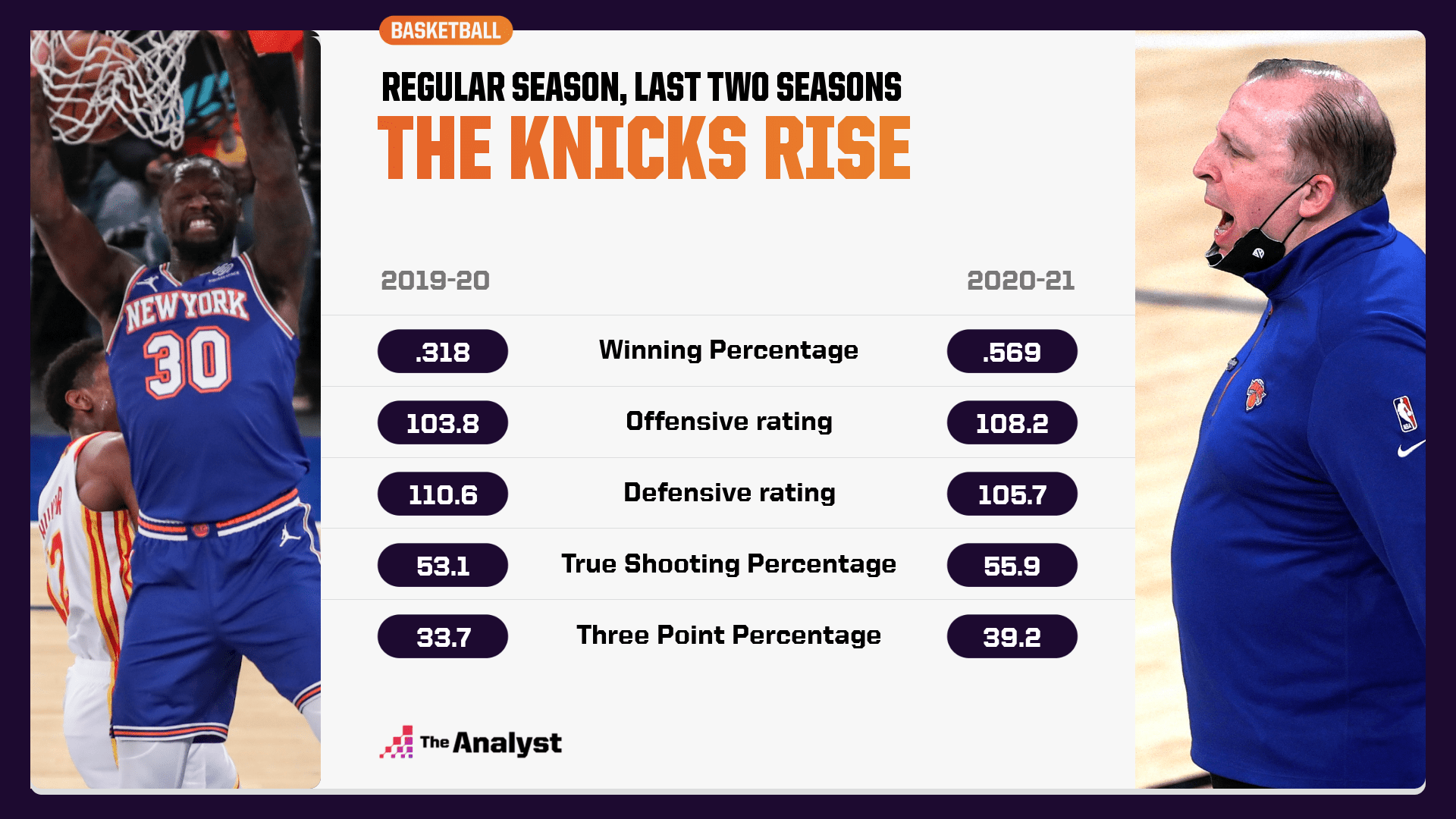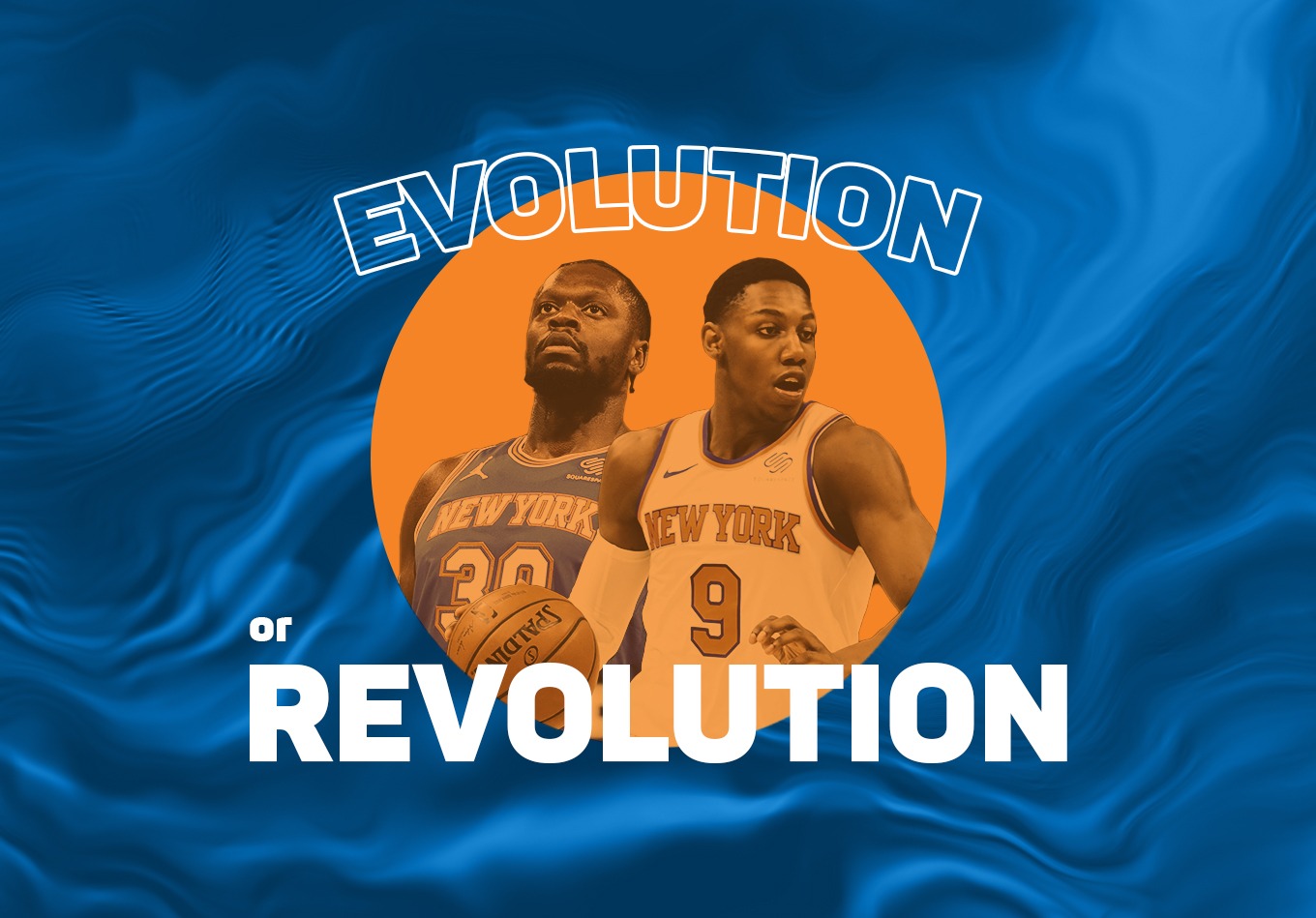Evolution or Revolution is a series that analyzes whether a team needs a few tweaks or a fundamental reboot. This edition focuses on whether the Knicks had a fluke season, or are on the road to contention.
It did not end as they might have hoped, but the 2020-21 NBA season was undoubtedly one to remember for the New York Knicks. Playoff basketball returned to Madison Square Garden for the first time in eight years, even if a typically passionate crowd could not carry their team beyond the first round.
The subsequent show of strength from the Atlanta Hawks – the fifth seed behind the Knicks – should cast a 4-1 series defeat in a slightly different light, though.
And New York’s progress under Coach of the Year Tom Thibodeau, led by Most Improved Player Julius Randle, can only encourage optimism. The 25.1 improvement in win percentage from the previous campaign (.318 to .569) was the largest in the franchise’s history.

But Thibodeau and the front office have work to do this offseason if they are to ensure the Knicks do not fall short when it really matters again next year.
Randle Raises the Level
With a reputation as one of the top defensive coach in the NBA, it came as little surprise that Thibodeau’s influence was most clearly seen on that end of the floor. The Knicks had given up 112.3 points per game in 2019-20, ranking 18th in scoring defense. That improved to a league-best 104.7 last season.
The fear was that the offense wouldn’t be up to par with the lack of talent on that side of the ball. However, Randle was determined not to let that side of the ball drag the team down and put in the work to improve his game heading into the new season, focusing particularly on his three-point shooting. “Obviously, the big thing was the three,” Thibodeau said in May. “It stood out right away during the summer, but you’re in the gym where there’s no defenders. It looked a lot better coming off his hand, the arc was better, and he looked real comfortable with it.” The Knicks’ leading scorer went from shooting 27.7 percent from three the previous year to 41.1.
Randle’s free-throw percentage also improved by nearly eight points to 81.1 percent. “I thought he would have a good year, but I didn’t see this level,” his coach added.
While Randle’s increased output (24.1 points per game) saw him supply 22.2 percent of his team’s points – ranking sixth in the league in that sense – and his usage rate rose to 29.3 percent, he also provoked better performances from his teammates.
“That was a big concern, the three-point shooting for our team,” said Thibodeau. “Not only for Julius, but that was huge for him and our team. All the other guys put in the extra time as well. Julius set the tone for that. You see him work on it every day. He’s in early, he stays late. He comes back at night, and we have a number of guys that do that. If you put the time into it, usually you’ll get a good result.”
No team improved their accuracy from beyond the arc as dramatically as the Knicks, up from 33.7 to 39.2 percent.
With increased options around him – including RJ Barrett shooting 44.1 percent from the field and 40.1 percent from three in his second year – Randle also had a career-high 6.0 assists per game. Of his 427 assists, 115 were for Barrett and 117 for Reggie Bullock. Considering he was assisted by Barrett on 68 occasions and then a further 55 from Elfrid Payton, Randle was involved in the Knicks’ four most common assist-scorer combinations. Following a narrow late-season defeat to the Lakers, Davis said of his former Pelicans teammate: “I think he’s an MVP candidate, he for sure should win Most Improved, what he’s doing, got this team in the playoffs right now for a team who hadn’t been in the playoffs for a while. He’s playing his a** off and you can do nothing but respect him.”
Julius Just Too Important?
The reliance on Randle is all well and good so long as the former seventh overall pick is delivering. Worryingly, though, a debut postseason series prompted an apparent regression to the mean – or worse.
Although that three-point practice kept his shooting from dipping below 33.3 percent from beyond the arc, Randle slumped to an alarming career low from the midrange, a miserable 14.7 percent. He was also 44.4 percent at the rim as the Knicks struggled to get points in the paint – Hawks center Clint Capela averaged a double-double for the series, his 13.4 rebounds including 10.4 on the defensive end – and ended up with just 18.0 points per game in 36.0 minutes, even as the usage rate ramped up even further to 31.8 percent.
No team can afford for their superstar to go missing in the playoffs. Randle had posted 28, 44 and 40 in three wins over the Hawks in the regular season, but he was swiftly stifled in round one. Meanwhile, Trae Young, revelling in the role of villain in New York, established himself as one of the league’s most exciting scorers.
Young’s 29.2 points against the Knicks set the standard for his postseason as a whole, with the Hawks beating the Philadelphia 76ers and only losing to the Milwaukee Bucks after their point guard was injured. Youg repeatedly rose to the occasion, providing a stark contrast for Randle.
Randle had entered the playoffs all but certain to be the subject of a hefty contract offer from the Knicks one year out from unrestricted free agency. Now, that deal is not quite so secure, with the team perhaps pondering their options.
Big Spenders or Big Savers?
As in 2020-21, when Thibodeau and the front office chose not to gamble, the Knicks are set to have the most cap space in the NBA, projected at $51.3 million. With money to spend in a big market, New York will – yet again – be the subject of speculation involving the league’s top free agents heading into the new season, especially if a Randle deal is delayed.
This is a somewhat underwhelming free agency class, though, with two notable exceptions. Kawhi Leonard and Chris Paul both have player options – the latter an interesting name given the Knicks’ issues at point guard.
Thibodeau finally lost patience with Payton after 13 playoff minutes, one point and one assist, while Frank Ntilikina appeared fleetingly in three games. That meant Derrick Rose starting at the point; although he led the team with 19.4 points per game in the postseason, they lost all three of his starts and badly missed his consistent contributions from the bench. The trio are all on expiring contracts and only Rose is likely to be retained. It is a position that must be reinforced.
Despite their repeated attempts to strike a blockbuster deal, a move for Paul or another free agent splash would represent a step into the unknown. The Knicks are far more familiar with fortifying the roster via the draft and will hope Barrett (2019), Immanuel Quickley and Obi Toppin (both 2020) will be boosted by getting a taste of the playoffs, even though the experience was brief.
Ideally, third-year center Mitchell Robinson would also have had that opportunity. He has the best career field-goal percentage on record among NBA players with 400 or more attempts all-time (70.5) but fractured his right hand in February and his right foot in March.
A Reprieve From the Lottery
The free agency rumor mill might continue to churn, but Knicks fans have this year at least been spared the pain of sitting through another draft lottery.
While not being able to take Cade Cunningham just as they were not able to select Zion Williamson in 2019, this time that is due to their own on-court achievements, rather than the luck of the draw. Two first-round picks – 19 and 21 – should still see New York able to bolster their roster.
Verdict: Evolution
Why would the Knicks do anything but build on the foundations of a popular, hard-working, fast-improving team? Whether Randle signs or not, whether a player like Paul can be tempted to MSG or otherwise, the bulk of this roster will remain the same. They have enough room under the cap to bring back several key pieces regardless of any expensive, eye-catching additional business.
A new man running point would allow Rose to return to leading the second unit. Another way to add scoring depth might see the arrival of a wing who can compete for minutes with Bullock, whose accuracy from the field, three-point range and the foul line tailed off in the postseason.
Up the middle, despite the team’s struggles against Capela and Co., Robinson remains under a team option and both Nerlens Noel ($6m last year) and Taj Gibson ($1.7m) should be cheap and useful enough to return. In 1,547 regular season minutes, Noel had the third-best block percentage (8.7) and 23rd-best steal percentage (2.3) in the league.
New York may still be some way off contention, but this must be a patient process. Another playoff campaign should be regarded as a success, particularly if they can be more competitive. That will require tweaks, not a drastic overhaul.
Design by Briggs Clinard.
